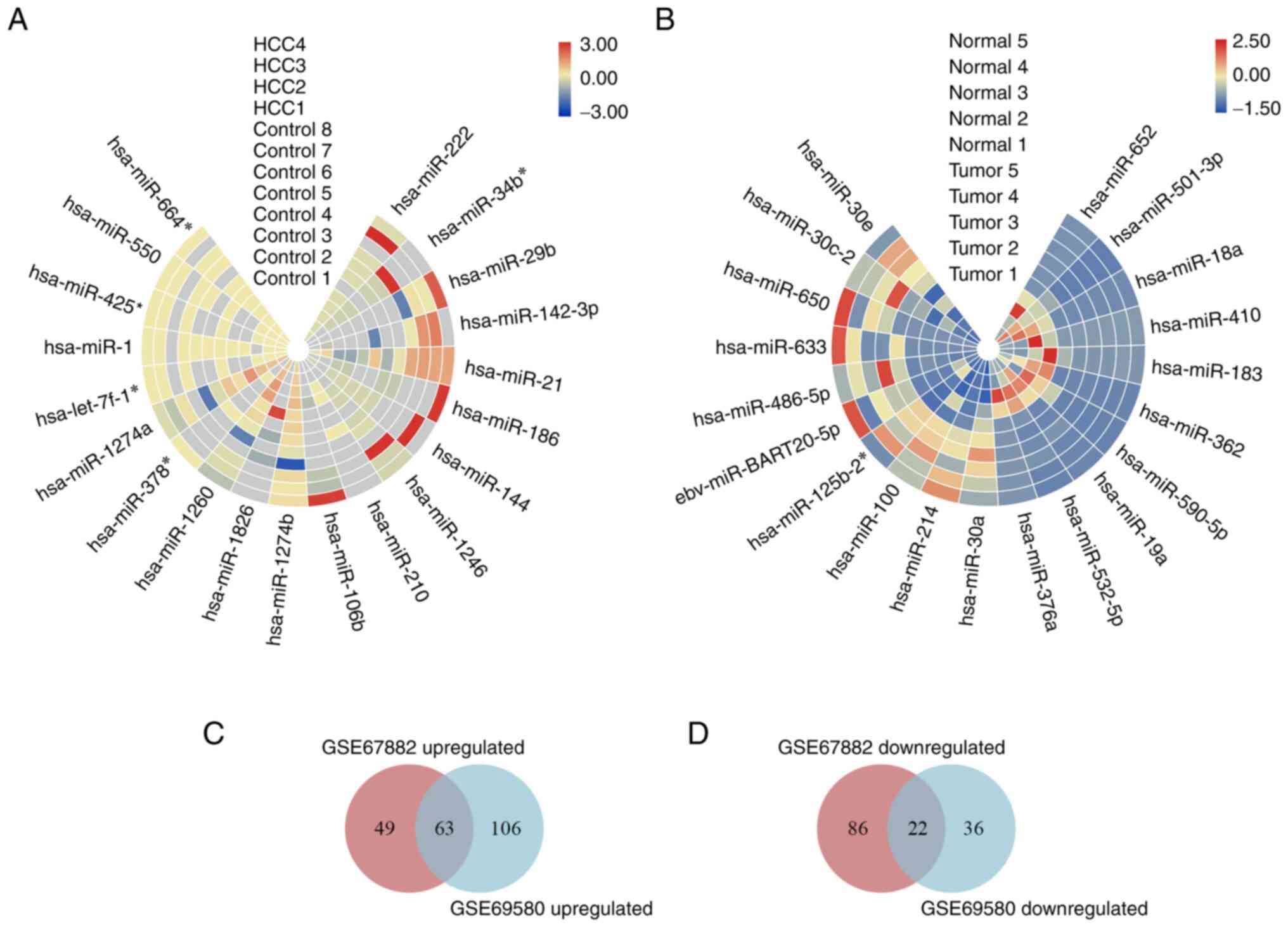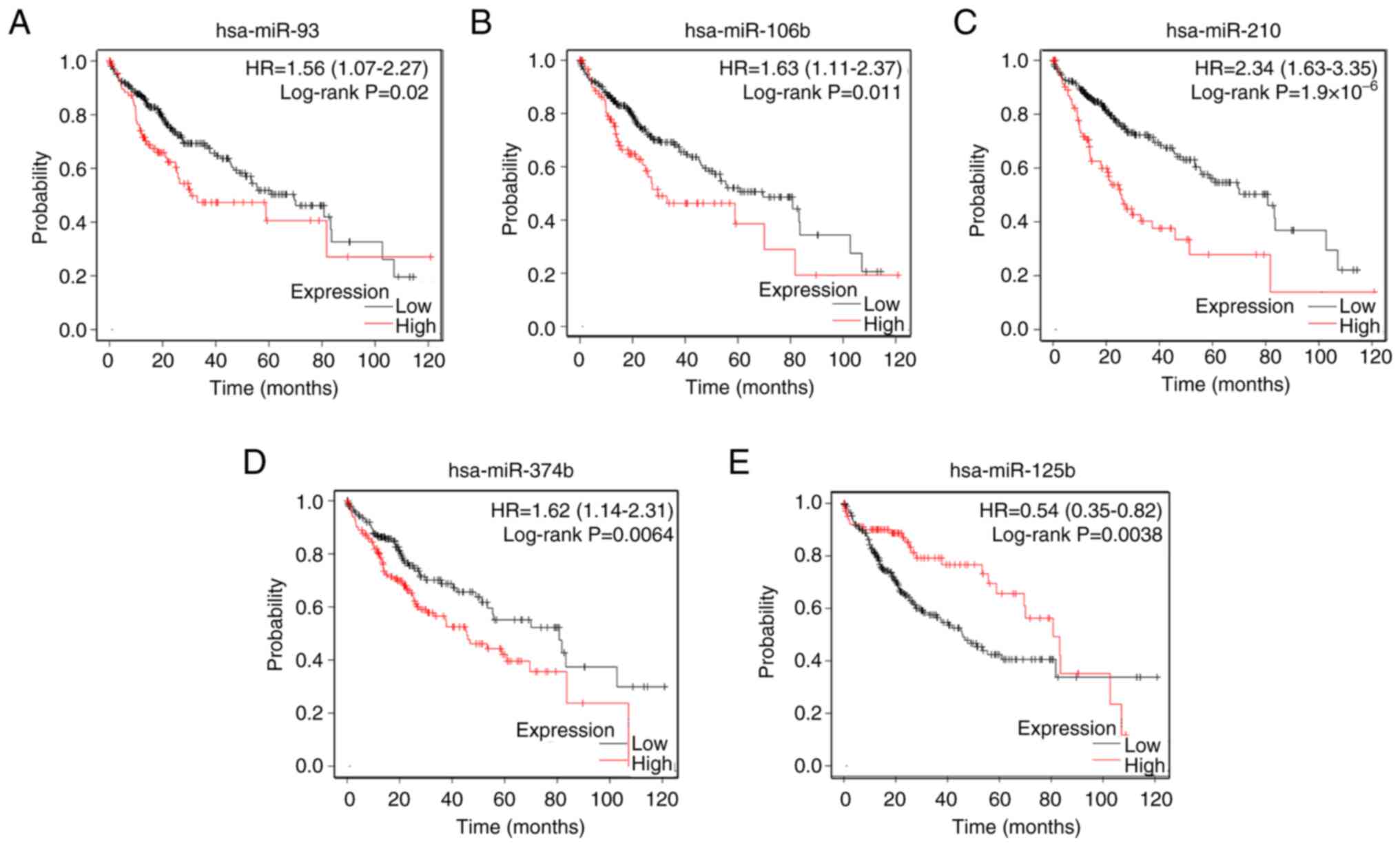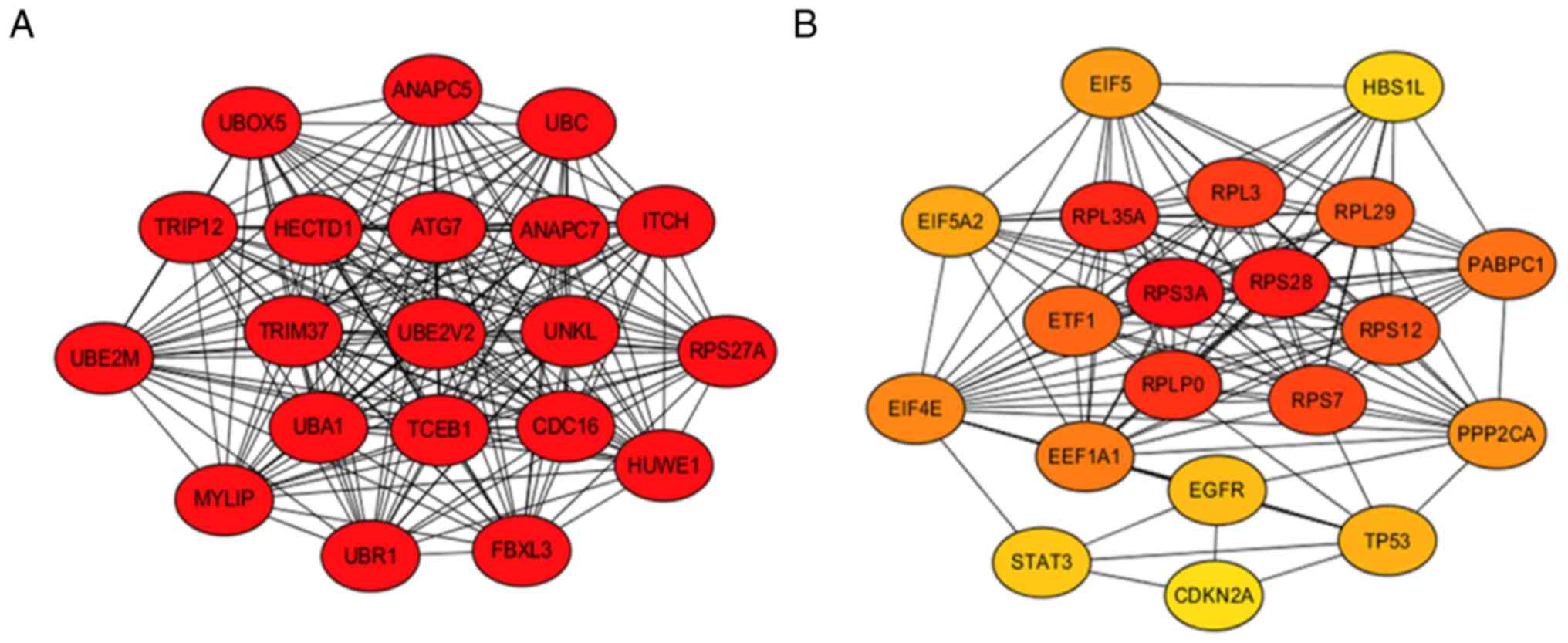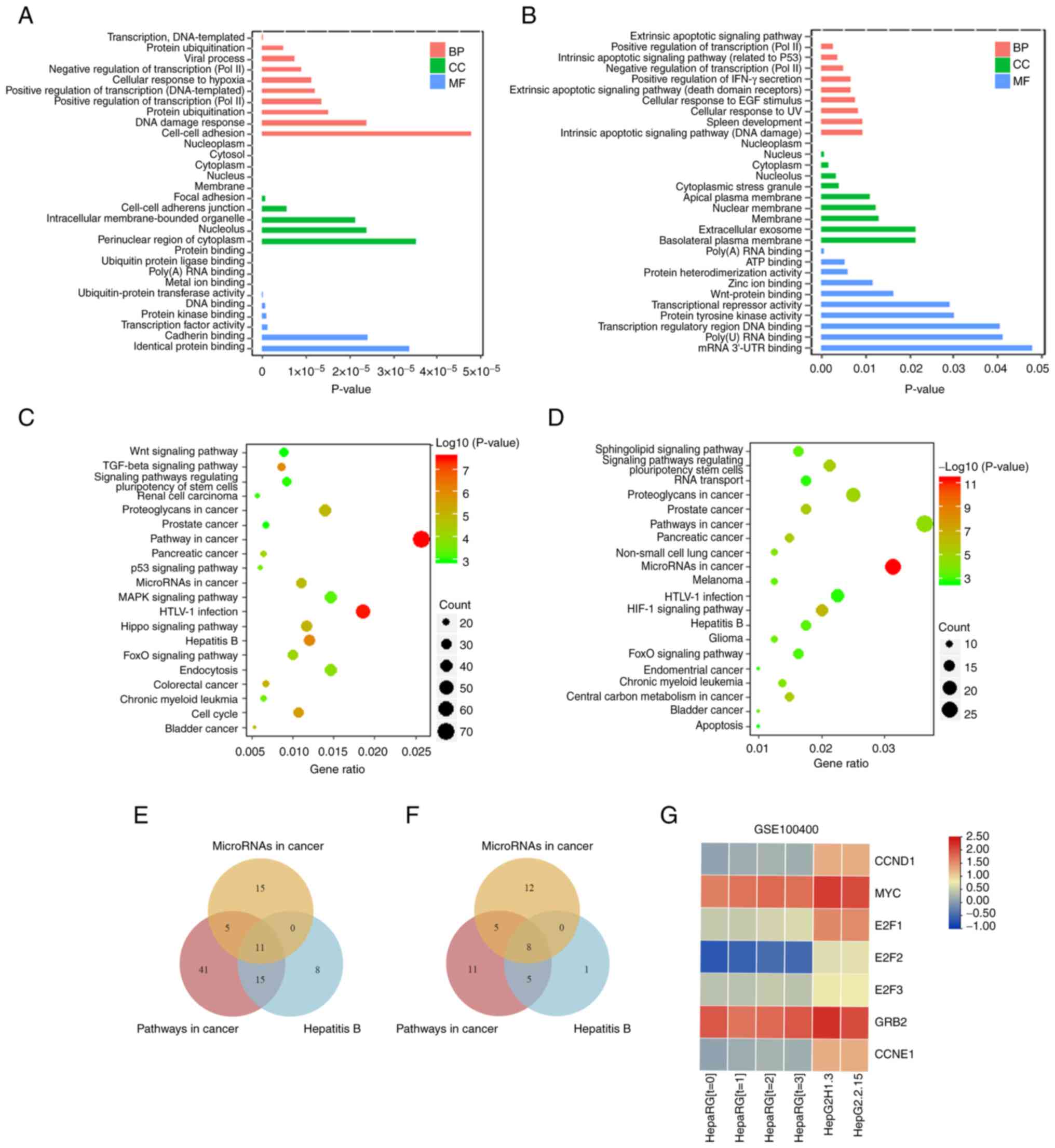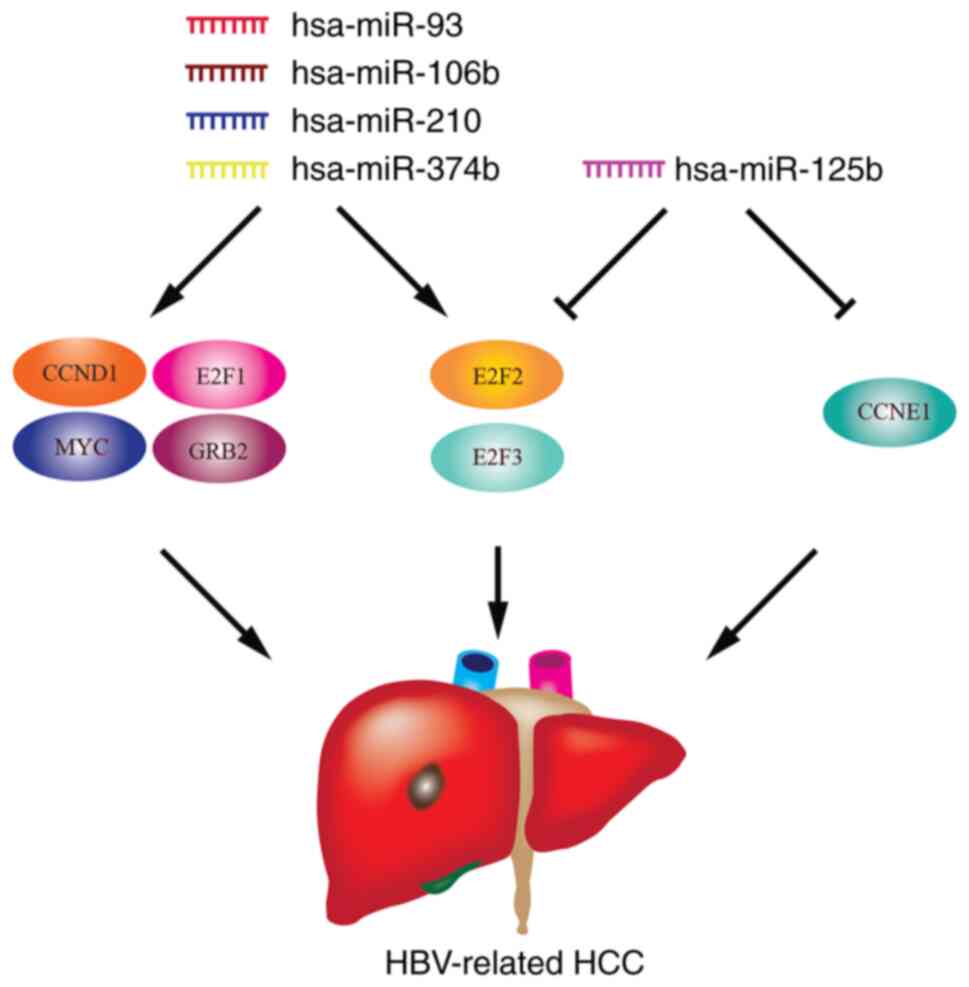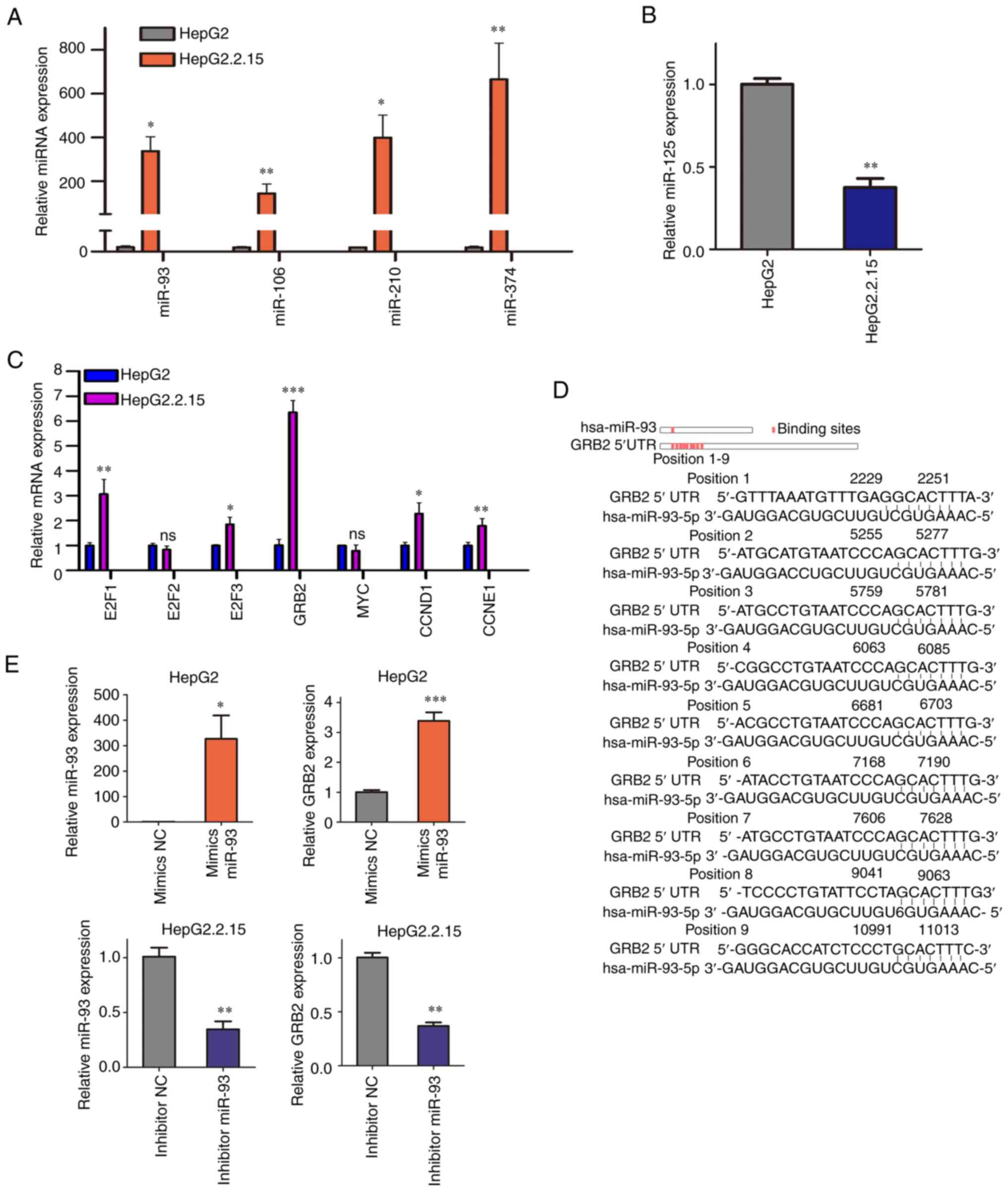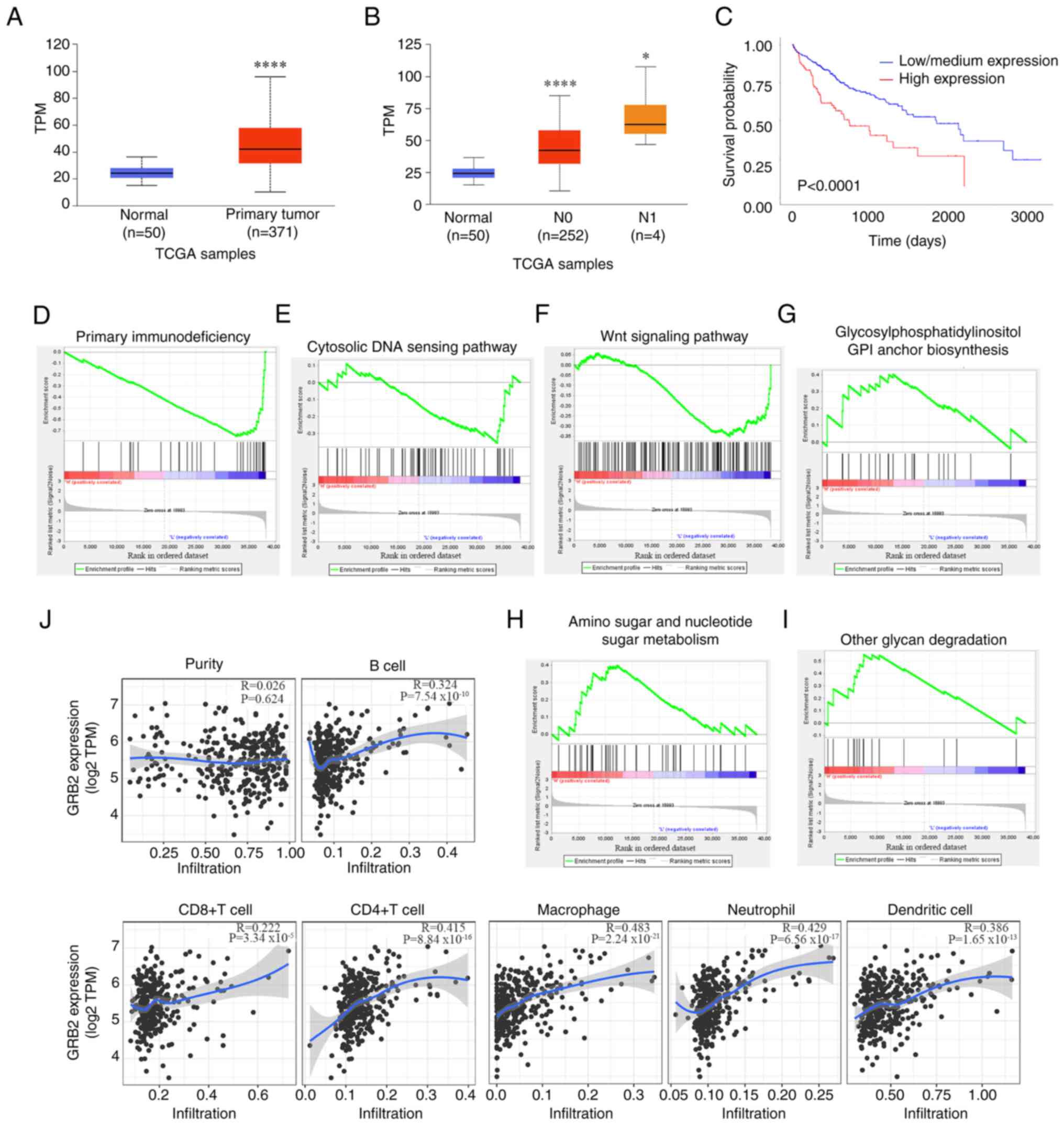miRNA‑mRNA network contributes to HBV‑related hepatocellular carcinoma via immune infiltration induced by GRB2
- Authors:
- Published online on: April 11, 2024 https://doi.org/10.3892/br.2024.1777
- Article Number: 90
-
Copyright: © Zheng et al. This is an open access article distributed under the terms of Creative Commons Attribution License.
Abstract
Introduction
Hepatocellular carcinoma (HCC) is the sixth most common type of malignant tumor and the fourth leading cause of cancer death worldwide. In 2018, global incidence of liver cancer was 4.7% and the mortality rate was 8.2% (1). Incidence of HCC has been increasing and the mortality rate has been growing faster than that of any other malignant tumor (2). Especially in developing countries, the prevalence of hepatitis B virus (HBV)-associated HCC remains high and is associated with local HBV epidemics (3).
HBV is a hepatotropic DNA virus infecting ~240 million people worldwide (4). HBV DNA is detected in serum and tissue samples from patients with HBV-related HCC (5). The mechanism by which HBV promotes HCC is unclear, but it is hypothesized that the pathogenesis of HCC is caused by chronic HB triggering cirrhosis (6). The mortality related to HBV-associated diseases, which account for ~600,000 deaths each year, is mainly caused by decompensated cirrhosis and HCC (7). HBV mediates cell proliferation and DNA damage by increasing oxidative stress and inflammation, which are key links in the pathological changes of HCC (8). A study also revealed that the high expression of the HBV X gene leads to HCC in transgenic mice (9). Therefore, it is necessary to study the uncovered mechanism of HBV in pathological changes in the liver.
MicroRNAs (miRNAs or miRs) have begun to receive widespread attention in the field of virology (10-12). miRNAs are non-coding RNAs with a length of ~22 nt that primarily control gene expression via post-transcriptional regulation patterns (13). Abnormally expressed miRNAs are often detected in patients with HCC and HBV infection and may be considered biomarkers for diagnosis and prognosis assessment, such as miR-375, miR-92a, miR-25 and let-7f (14,15). miRNAs serve a number of functions in vivo to regulate cell invasion, migration, proliferation, apoptosis and metabolism (16-19). Additionally, miRNAs serve a critical role in the process of oxidative stress, inflammation and autophagy (20,21). HBV can influence the expression of miRNAs at multiple stages following infection (22). However, expression patterns of numerous miRNAs, such as miR-125b and miR-210, remain controversial in patients with HBV-associated HCC: Some researchers believe that miR-125b and miR-210 are highly expressed in HCC, while others believe that the expression of the two miRNAs is low in HCC (23-27).
Researchers have reported that miR-125b and miR-210 can be up- or downregulated in patients with HBV-associated HCC (23-25). Certain miRNAs have only been evaluated in a few studies of HBV-related HCC, and their biological changes and mechanisms need to be further elucidated, such as miR-374b (28,29). Therefore, the regulatory mechanism of miRNAs in HCC needs to be further studied.
Proteins serve a vital role in the occurrence and development of tumors (30). Previous studies have demonstrated that miRNAs in the cytoplasm inhibit gene expression by binding to the 3' untranslated region (UTR) of the gene to inhibit translation or direct degradation of mRNAs (31,32). However, unlike the role of cytoplasmic miRNA, miRNAs in the nucleus are primarily involved in regulating transcription (33). miRNAs, such as miR-373, miR-744 and miR-1186, are located in the nucleus and can combine with promoter or enhancer regions to activate gene expression (33). The present study aimed to use bioinformatics methods using the Gene Expression Omnibus (GEO) database and R programming language to identify the HBV-associated miRNA-mRNA regulatory network.
Materials and methods
Analysis with R programming language
The ‘limma’ package was obtained from Bioconductor (bioconductor.org/biocLite) and was employed to analyze the data via R software (version 4.0.0). RNA sequencing (-seq) data was imported into the R environment and converted into a data structure supported by ‘DESeq2’ package (bioconductor.org/biocLite). Original data was preprocessed by standardizing the data, removing low-expression genes and batch effects. R language ‘limma’, ‘dplyr’ and ‘tidyr’ packages (bioconductor.org/biocLite) were used for differential expression gene analysis. R package ‘ggplot2’ was applied to visualize the results. Heatmap results of the miRNAs and differential gene expression were produced with TBtools (version 1.09876) (34).
Non-coding RNA profiling by array
The miRNA expression database was established by searching GEO Data Sets (ncbi.nlm.nih.gov). The inclusion criteria were samples must be pathologically confirmed as HCC patients and miRNA expression profiles are detected in tumor and adjacent normal tissues. Through screening, two datasets containing samples from tissues of patients with HCC were included: GSE67882 and GSE69580. A total of 13 HCC and nine non-tumor tissues were included in the present study. These patients with HCC had diagnosis confirmed through pathological examination. The ‘limma’ R package was applied to compare expression levels of miRNAs between HBV-related HCC and the corresponding non-tumor tissues from the two series of matrix files. After data normalization, expression levels of the miRNAs in the two datasets were analyzed.
Analysis of prognostic value of differentially expressed miRNAs (DE-miRNAs)
The prognostic values of DE-miRNAs in HCC were analyzed using the Kaplan-Meier Plotter database (kmplot.com/analysis/index.php?p=service&cancer=liver_mirna). Through comparing the relationship between miRNA expression levels and the survival rate of HCC patients, the DE-miRNAs with an impact on the prognosis of patients with HBV-related HCC were selected for further analysis.
DE-miRNA target gene prediction
miRNet (mirnet.ca/miRNet/home.xhtml), an easy-to-use analysis tool based on an online network, was used to predict the miRNA target genes (35). miRNet integrates data from 11 high-quality miRNA-target interaction databases and displays the results through a network visualization system. Gephi software (version 0.9.2, gephi.org/users/), a network visualization software based on the JAVA working environment, displayed the regulatory association between miRNAs and their target genes.
miRNA-hub gene prediction
Cytoscape software (version 3.7.1, https://github.com/cytoscape/cytoscape) was used to evaluate the miRNA hub genes. For all DE-miRNA target genes, Molecular Complex Detection plug-in (version 3.3.10, http://apps.cytoscape.org/) was used for scoring according to the interaction between the genes. The higher the score, the more key the role the hub genes play in the entire gene network.
Functional annotation and signal pathway enrichment analysis
Database for Annotation, Visualization and Integrated Discovery (DAVID; david.ncifcrf.gov/home.jsp) was applied for Gene Ontology (GO) and Kyoto Encyclopedia of Genes and Genomes (KEGG) analysis of DE-miRNA target genes. For GSE101728 data, containing the expression profiling of lncRNA and mRNA in HCC (36), the enrichment of KEGG pathway according to the top 25% of the highest and lowest GRB2 expression patients' genes expression profiling was assessed.
HBV-associated HCC target gene prediction
HBV-associated experimental data were screened through the GEO database. In the GSE100400 dataset, the researchers combined circularized chromosome conformation capture (4C) with RNA-seq and chromatin immunoprecipitation (ChIP)-seq to illuminate the nuclear landscape associated with HBV episomes and HBx (37). To the best of our knowledge, the aforementioned study is the first to use 4C to identify regional virus-host genome interactions. By using R programming language tool, expression matrix of RNA-seq data in GSE100400 was obtained and the difference in gene expression was calculated.
The Cancer Genome Atlas (TCGA) database analysis
UALCAN database (ualcan.path.uab.edu/) is an easy-to-use interactive web portal that for in-depth analysis of TCGA gene expression data. UALCAN includes TCGA RNA-seq and clinical data from 31 types of cancer (38). This was used to select genes with significant differences in expression and prognosis between tumors and corresponding adjacent tissues.
Immune infiltrate analysis
The Tumor Immune Estimation Resource (TIMER) database (cistrome.shinyapps.io/timer/) is designed to investigate the molecular characteristics of tumor-immune interactions and analyze the correlation between gene expression and the abundance of immune infiltrates (39). This was used to screen genes related to immune infiltration.
Cell culture and transfection
Human hepatoblastoma cell lines (HepG2 and HepG2.2.15) were purchased from Guangzhou Cellcook Biotech Co., Ltd. and were authenticated via STR profiling. The hepatoblastoma cells were grown in Minimal Essential Medium supplemented with non-essential amino acids and 10% fetal bovine serum (all WISENT, Inc.). Cells were placed in a cell incubator (Thermo Fisher Scientific, Inc.) at 37˚C with 5% carbon dioxide. miRNA-93 mimics and inhibitors and negative controls (Guangzhou RiboBio Co., Ltd.) were prepared for cell transfection. The confluence of the cells was maintained at ~60% before transfection. Cells were starved in serum-free Minimal Essential Medium (WISENT, Inc.) at 37˚C with 5% carbon dioxide for 2 h and transfected with 1 µg miRNA-93 mimics and inhibitors and their respective blank vectors using Lipofectamine 2000 reagent (Invitrogen; Thermo Fisher Scientific, Inc.) for 36 h at 37˚C. Subsequent experiment was conducted within 72 h. The sequences of the miRNA-93 mimics/inhibitors are displayed in Table SI. The sequence of mature miRNA-93 was 5'-CAAAGUGCUGUUCGUGCAGGUAG-3'. The sequence of mimics negative control was 5'-UUGUACUACACAAAAGUACUG-3' and inhibitor negative control was 5'-CAGUACUUUUGUGUAGUACAA-3'.
RNA extraction and reverse transcription-quantitative PCR (RT-qPCR)
Total RNA of the cells was extracted using TRIzol (Invitrogen; Thermo Fisher Scientific, Inc.). RT was performed using a PrimeScript™ RT reagent Kit (Takara Bio, Inc., No RR047A) according to the manufacturer's instructions. A SYBR Premix Ex Taq II kit (Takara Bio, Inc.) was used for RT-qPCR with thermocycling conditions as follows: initial denaturation 95˚C, 30 sec; 40 cycles of denaturation 95˚C, 30 sec, annealing at 60˚C 30 sec and extension 72˚C, 30 sec. StepOne Plus system (Applied Biosystems; Thermo Fisher Scientific, Inc.) was employed. Target gene expression was normalized using the 2-ΔΔCq method (40). The sequences of mature miRNAs are presented in Table SII; RT-qPCR primers (Shanghai GenePharma Co., Ltd.) are displayed in Table SIII.
Statistical analysis
All experimental data with at least 3 times are presented as the mean ± standard deviation using GraphPad Prism (version 5.0; Dotmatics) and the statistical analysis was performed using SPSS 20.0 (IBM Corp.). Differences between the two groups was analyzed using paired t tests. For >2 groups in TCGA database, One-way ANOVA was used followed by Fisher's least significant difference post hoc test. The correlation analysis between two genes was evaluated using the Spearman rank correlation coefficient. All plots were drawn with GraphPad Prism software. For the results of miRNA microarray, P<0.05 and |log2fold-change (FC)|> 1 were considered to define the DE-miRNAs. The association between expression of DE-miRNAs and the prognostic value was analyzed using log-rank test. P<0.05 was considered to indicate a statistically significant difference.
Results
Screening of potential DE-miRNAs in HBV-associated HCC
The original data of miRNA arrays GSE67882 and GSE69580 were obtained and normalized (Fig. S1). A total of 13 HCC and nine non-tumor tissues were included for further analysis. The ‘limma’ R package was used to generate volcano plots of miRNA expression (Fig. S2). The top 10 up- and downregulated genes are displayed as heatmaps (Fig. 1A and B). Intersection analysis showed that there were 63 up- and 22 downregulated genes (Fig. 1C and D). The candidate DE-miRNAs were defined according to two indicators |log2FC|>1 and P<0.05. Following screening, nine up- and one downregulated DE-miRNA were obtained (Table I).
Prognostic value of DE-miRNAs
To evaluate candidate DE-miRNAs, their prognostic value was analyzed. Kaplan-Meier Plotter database showed that among nine upregulated miRNAs, only four miRNAs, namely miRNA-93, miRNA-106b, miRNA-210 and miRNA-374b, had a significant effect on prognosis of patients with HCC (Fig. 2A-D). The prognostic analysis of miRNA-125b showed that the lower the expression of miRNA-125b, the worse the prognosis (Fig. 2E). Finally, five miRNAs whose expression levels and prognosis were significantly different between HCC and normal tissue were identified as candidate DE-miRNAs for further study.
Prediction of DE-miRNAs target and hub genes
The target genes of DE-miRNAs were predicted in miRNet database. miRNA-93 had 1,220, miRNA-106b had 1,091, miRNA-210 had 124, miRNA-374b had 234 and miRNA-125b had 432 potential target genes (Fig. S3A and B; Table II). Protein-protein interaction network analysis was performed on predicted target genes of DE-miRNA using the STRING database and Cytoscape software (version 3.7.1; Fig. 3A and B). The top 20 resulting hub genes are displayed, as well as their scores (Table SIV).
Functional annotation and pathway enrichment analysis
The present study evaluated the terms involved in these target genes through GO analysis. DAVID (version 6.8) database was used to perform GO enrichment analysis of 2,669 predicted target genes of up- and 432 predicted target genes of downregulated DE-miRNAs. The results were divided into three categories: Biological process, cellular component and molecular function. The top ten terms are listed according to P-value (Fig. 4A and B). KEGG pathway enrichment analysis of target genes was performed using the DAVID database to evaluate the signaling pathways. The top 20 terms are displayed according to P-value (Fig. 4C and D). Notably, three signal pathways (‘pathway in cancer’, ‘hepatitis B’ and ‘microRNAs in cancer’) were co-enriched, which were associated with HBV-related HCC. To identify potential target genes regulated by HBV, these signaling pathways were selected for intersection analysis, resulting in 11 and 8 sets of intersecting genes for up- and downregulated genes, respectively (Fig. 4E and F). For these predicted target genes, experimental data from GEO database were further investigated. In GSE100400 dataset, RNA-seq, ChIP-seq and 4C methods were combined to identify target genes regulated by HBV (37). Since this dataset provided a reliable and well-analyzed differential gene expression profile, it was cross-analyzed with the present findings to predict the potential miRNA-mRNA regulatory relationship network in HBV-related HCC. An intersection analysis of 11 up- and 8 downregulated target genes with the results of GSE100400 was conducted. A total of seven HBV-associated intersecting genes was obtained: CCND1, MYC, E2F1, E2F2, E2F3, GRB2 and CCNE1. The sequencing expression profiles of these genes in the GSE100400 dataset is shown in Fig. 4G. The expression levels of the DE-miRNA target genes were analyzed via UALCAN cancer database (Fig. S4). The present study summarized the potential miRNA-mRNA regulatory association network model in HBV-associated HCC (Fig. 5).
Verification of candidate miRNAs and potential target genes and exploration of the regulatory association
To validate the results of the bioinformatics analysis, the expression levels of DE-miRNAs and target genes in HepG2 and HepG2.2.1.5 (a cell line that stably expresses HBV) (41) cells were detected. Compared with those in HepG2 cells, miRNA-93, miRNA-106b, miRNA-210 and miRNA-374b showed significantly higher expression levels in HepG2.2.1.5 cells, while miRNA-125b showed significantly lower expression (Fig. 6A and B). Similarly, compared with HepG2 cells, expression levels of E1F1, E2F3, GRB2, CCND1 and CCNE1 were higher than those in HepG2.2.15 cells, while expression levels of E2F2 and MYC were not significantly different (Fig. 6C).
Base pairing analysis demonstrated that miRNA-93 had binding sites not only in the 3' but also the 5' UTR of GRB2. A total of nine potential binding sites was predicted between miRNA-93 and 5' UTR of GRB2 (Fig. 6D). As aforementioned, in HepG2.2.15 cells with HBV overexpression, the expression levels of miRNA-93 and GRB2 were upregulated. According to the predicted binding site, miRNA-93 has a regulatory effect of activation by targeting the GRB2 5' UTR. Therefore, more attention was paid to the active regulation between miRNA-93 and GRB2.
Transfection was performed to detect the effect of miRNA-93 on GRB2 expression levels in vitro. Mimics of miRNA-93 were transfected into HepG2 cells and changes in GRB2 were detected. With the increase in miRNA-93, the expression of GRB2 also increased (Fig. 6E). In addition, transfection of miRNA-93 inhibitors in HepG2.2.15 cells confirmed that the expression of GRB2 decreased with the knockdown of miRNA-93 (Fig. 6E). Thus, GRB2 was a target gene of miRNA-93 and was positively regulated by miRNA-93.
Prediction of the mechanism of GRB2 promotion of HCC
TCGA database demonstrated that expression levels of GRB2 in HCC were significantly higher than those in non-tumor tissues (Fig. 7A). Expression of GRB2 was associated with lymph node metastasis in patients with HCC (Fig. 7B). The higher the GRB2 expression, the lower the overall survival rate of patients with HCC (Fig. 7C).
The present study analyzed the role of GRB2 in occurrence and development of HCC. After GSE101728 data normalization, the present study assessed enrichment of the KEGG pathway between the top 25% of the highest and lowest GRB2 expression (Fig. 7D-I). Primary immunodeficiency signaling pathway had the smallest P-value in the low GRB2 expression group.
The association between GRB2 expression and immune infiltration levels in HCC were assessed using the TIMER database. Spearman's correlation was assessed based on microarray expression levels. High GRB2 expression had positive correlations with the infiltration levels of B (R=0.324) and CD4+ T cells (R=0.415), macrophages (R=0.483), neutrophils (R=0.429) and dendritic cells (R=0.386) in HCC (Fig. 7J). GRB2 expression had a weakly positive correlation with the infiltration of CD8+ T cells (R=0.222) and no significant correlation with tumor purity (R=0.026). These findings suggest that GRB2 may serve a specific role in immune infiltration in HCC, especially for CD4+ T cells, macrophages and neutrophils.
Discussion
Although HBV-related miRNA-mRNA regulatory networks have been considered in previous studies (42,43), the miRNA-mRNA network regulated by HBV needs to be further explored due to continuous updating of databases with different patient samples and technologies. Advanced studies have implied that these factors can predict bioinformatic data more accurately (44,45).
HBV is widely integrated into the host genome and has four open reading frames, primarily encoding four viral proteins: Polymerase, HBx, envelope and core protein. HBx) serves a key role in regulating the replication of HBV and is involved in carcinogenesis associated with HBV (46). HBx can be detected in the nucleus, cytoplasm and plasma (47,48). In the nucleus, HBx directly regulates downstream target genes through gene transcription, while in the cytoplasm, HBx regulates downstream target genes via multiple signaling pathways (49). Similarly, miRNAs are widely distributed in human cells and can be detected in the cytoplasm and nucleus (33). HBx and miRNAs are colocalized in the nucleus, which suggests that HBx is a key molecule that participates in HBV regulation of miRNAs (50,51).
miRNAs are important gene expression regulators that can bind to complementary target mRNAs and inhibit their expression (52,53). They mainly play a role in translation inhibition by targeting the 3' UTR of mRNA and causing its cleavage and degradation (54). Analysis of the interaction sites between miRNAs and target genes demonstrated that most miRNAs have binding sites in the 3' UTR of the gene and a small number of predicted binding sites are located in the coding sequence region of the gene (54). However, the present study demonstrated that miRNA-93 upregulates the expression of GRB2, while most miRNAs inhibit gene expression (55). A previous study showed that miRNAs located in the nucleus change the chromatin state by binding to enhancers to activate gene transcription (56). Subsequent research confirmed the phenomenon of miRNA activation (57). miRNAs can suppress gene expression in the cytoplasm and activate gene transcription in the nucleus. In breast cancer, miRNA-93 is localized in the nucleus (58). The present study did not clarify the miRNA-93 localization or chromatin state of the GRB2 enhancer region. This would provide understanding of how miRNA-93 is involved in transcriptional regulation in the nucleus.
GRB2, an oncogenic functional gene in HCC, mainly regulates cell proliferation and invasion via the ERK1/2/AKT axis (59). A previous article identified that GRB2-associated binding proteins serve important roles in the regulation of immune response and cancer cell signaling (60). In addition, miRNA-93 regulates FAT atypical cadherin 4 expression, which is associated with prognosis and immune cell infiltration in HCC (61). The aforementioned report suggested that miRNA-93 was indirectly involved in tumor immune regulation. Several studies have reported that tumor-infiltrating lymphocytes are an independent predictor of lymph node status and survival in cancer (62,63). The present bioinformatics analysis indicated that GRB2 expression can be treated as a biomarker to evaluate the prognosis of HCC patients and regulate the tumor immune microenvironment. There was moderate correlation between GRB2 and immune cells, such as CD4+ T cells, macrophages and neutrophils. The high expression of GRB2 in HCC is accompanied by aggregation of these immune cells. GRB2 may lead to progression of HCC by affecting the tumor immune microenvironment (64). HBV-positive patients have long-term chronic viral infection (65). Liver macrophages are stimulated by HBV-associated inflammatory cytokines and chemokines and can adjust their phenotype based on different signals from the liver microenvironment, such as danger signals, fatty acids, and phagocytosis of cell debris, thereby affecting tumor progression (66). In previous studies, macrophages were not considered to have antigen-specific immune memory (67,68). However, macrophages, as a class of immune cells, can also form antigen-specific immune memory (69). When macrophages encounter a specific antigen again, they stimulate a stronger immune response. This indicates a function of macrophages in HBV-related HCC.
Collectively, the present study summarized a potential miRNA-mRNA regulatory network in HBV-associated HCC and demonstrated miRNA-93 positively regulated immune infiltration-related GRB2 gene expression through the 5'UTR region. This study reports for the first time the correlation between GRB2 expression and immune cell infiltration. Restoring GRB2 levels may be a novel treatment strategy for HCC in future.
Supplementary Material
Normalized data of GSE67882 and GSE69580. GSE67882 data (A) before and (B) following normalization. GSE69580 data (C) before and (D) following normalization.
Volcano plots of GSE67882 and GSE69580 data. Volcano plot of (A) GSE67882 and (B) GSE69580 data. The candidate differentially expressed microRNAs were defined as fold-change >2 and P<0.05.
miRNet prediction of potential target genes of DE-miRNAs in HBV-related HCC. (A) Four up- and (B) one downregulated DE-miRNAs and corresponding predicted target genes. Certain genes were simultaneously regulated by several miRNAs.
Expression levels of seven differentially expressed microRNA target genes were dysregulated in UALCAN database. Differential expression levels of (A) Cyclin D1), (B) MYC, (C) E2F1 (E2F Transcription Factor 1), (D) E2F2 (E2F Transcription Factor 2), (E) E2F3 (E2F Transcription Factor 3), (F) GRB2 (Growth Factor Receptor Bound Protein 2) and (G) CCNE1 (Cyclin E1) in tumor and normal tissue according to ethnicity. ns, not significant.
Sequences of the miRNA-93 mimics/inhibitors used for transfection.
Sequence of mature miRs.
Reverse transcription-quantitative PCR primers.
Hub genes identified in the cytoHubba network.
Acknowledgements
Not applicable.
Funding
Funding: The present study was supported by the National Natural Science Foundation of China (grant no. 81972664).
Availability of data and materials
The data generated in the present study may be requested from the corresponding author.
Authors' contributions
CZ and HF conceived the study. CZ, HS, ML and YQ designed the methodology, performed experiments and analyzed data. CZ wrote the manuscript. CZ, HS, ML and HF edited the manuscript. HF supervised the study. CZ and HS confirm the authenticity of all the raw data. All authors have read and approved the final manuscript.
Ethics approval and consent to participate
Not applicable.
Patient consent for publication
Not applicable.
Competing interests
The authors declare that they have no competing interests.
References
|
Bray F, Ferlay J, Soerjomataram I, Siegel RL, Torre LA and Jemal A: Global cancer statistics 2018: GLOBOCAN estimates of incidence and mortality worldwide for 36 cancers in 185 countries. CA Cancer J Clin. 68:394–424. 2018.PubMed/NCBI View Article : Google Scholar | |
|
Younes R and Bugianesi E: Should we undertake surveillance for HCC in patients with NAFLD? J Hepatol. 68:326–334. 2018.PubMed/NCBI View Article : Google Scholar | |
|
Sartorius K, Makarova J, Sartorius B, An P, Winkler C, Chuturgoon A and Kramvis A: The regulatory role of MicroRNA in hepatitis-B virus-associated hepatocellular carcinoma (HBV-HCC) pathogenesis. Cells. 8(1504)2019.PubMed/NCBI View Article : Google Scholar | |
|
El-Serag HB: Epidemiology of viral hepatitis and hepatocellular carcinoma. Gastroenterology. 142:1264–1273.e1. 2012.PubMed/NCBI View Article : Google Scholar | |
|
Sagnelli C, Macera M, Pisaturo M, Zampino R, Coppola M and Sagnelli E: Occult HBV infection in the oncohematological setting. Infection. 44:575–582. 2016.PubMed/NCBI View Article : Google Scholar | |
|
Ringelhan M, O'Connor T, Protzer U and Heikenwalder M: The direct and indirect roles of HBV in liver cancer: Prospective markers for HCC screening and potential therapeutic targets. J Pathol. 235:355–367. 2015.PubMed/NCBI View Article : Google Scholar | |
|
Szpakowski JL and Tucker LY: Causes of death in patients with hepatitis B: A natural history cohort study in the United States. Hepatology. 58:21–30. 2013.PubMed/NCBI View Article : Google Scholar | |
|
Choi YM, Lee SY and Kim BJ: Naturally occurring hepatitis B virus mutations leading to endoplasmic reticulum stress and their contribution to the progression of hepatocellular carcinoma. Int J Mol Sci. 20(597)2019.PubMed/NCBI View Article : Google Scholar | |
|
Kim CM, Koike K, Saito I, Miyamura T and Jay G: HBx gene of hepatitis B virus induces liver cancer in transgenic mice. Nature. 351:317–320. 1991.PubMed/NCBI View Article : Google Scholar | |
|
Sadri Nahand J, Bokharaei-Salim F, Karimzadeh M, Moghoofei M, Karampoor S, Mirzaei HR, Tabibzadeh A, Jafari A, Ghaderi A, Asemi Z, et al: MicroRNAs and exosomes: Key players in HIV pathogenesis. HIV Med. 21:246–278. 2020.PubMed/NCBI View Article : Google Scholar | |
|
Petrini E, Caviglia GP, Abate ML, Fagoonee S, Smedile A and Pellicano R: MicroRNAs in HBV-related hepatocellular carcinoma: Functions and potential clinical applications. Panminerva Med. 57:201–209. 2015.PubMed/NCBI | |
|
Pu C, Wang J, Wei Q and Han P: Commentary on ‘Asymptomatic prostatic inflammation in men with clinical BPH and erectile dysfunction affects the positive predictive value of prostate-specific antigen’. Agnihotri S, Mittal RD, Kapoor R, Mandhani A, Department of Urology & Renal Transplantation, Sanjay Gandhi Post Graduate Institute of Medical Sciences, Lucknow, India: Urol Oncol 2014; [Epub ahead of print]. doi: 10.1016/j.urolonc.2014.03.004. Urol Oncol. 33:103–104. 2015.PubMed/NCBI View Article : Google Scholar | |
|
Kelly EJ and Russell SJ: MicroRNAs and the regulation of vector tropism. Mol Ther. 17:409–416. 2009.PubMed/NCBI View Article : Google Scholar | |
|
Li LM, Hu ZB, Zhou ZX, Chen X, Liu FY, Zhang JF, Shen HB, Zhang CY and Zen K: Serum microRNA profiles serve as novel biomarkers for HBV infection and diagnosis of HBV-positive hepatocarcinoma. Cancer Res. 70:9798–9807. 2010.PubMed/NCBI View Article : Google Scholar | |
|
Bertoli G, Cava C and Castiglioni I: MicroRNAs: New biomarkers for diagnosis, prognosis, therapy prediction and therapeutic tools for breast cancer. Theranostics. 5:1122–1143. 2015.PubMed/NCBI View Article : Google Scholar | |
|
Ma X, Feng J, Lu M, Tang W, Han J, Luo X, Zhao Q and Yang L: microRNA-501-5p promotes cell proliferation and migration in gastric cancer by downregulating LPAR1. J Cell Biochem. 121:1911–1922. 2020.PubMed/NCBI View Article : Google Scholar | |
|
Vautrot V, Chanteloup G, Elmallah M, Cordonnier M, Aubin F, Garrido C and Gobbo J: Exosomal miRNA: Small molecules, big impact in colorectal cancer. J Oncol. 2019(8585276)2019.PubMed/NCBI View Article : Google Scholar | |
|
Sur S, Steele R, Shi X and Ray RB: miRNA-29b inhibits prostate tumor growth and induces apoptosis by increasing bim expression. Cells. 8(1455)2019.PubMed/NCBI View Article : Google Scholar | |
|
Vienberg S, Geiger J, Madsen S and Dalgaard LT: MicroRNAs in metabolism. Acta Physiol (Oxf). 219:346–361. 2017.PubMed/NCBI View Article : Google Scholar | |
|
Portal-Núñez S, Esbrit P, Alcaraz MJ and Largo R: Oxidative stress, autophagy, epigenetic changes and regulation by miRNAs as potential therapeutic targets in osteoarthritis. Biochem Pharmacol. 108:1–10. 2016.PubMed/NCBI View Article : Google Scholar | |
|
Guo D, Liu J, Wang W, Hao F, Sun X, Wu X, Bu P, Zhang Y, Liu Y, Liu F, et al: Alteration in abundance and compartmentalization of inflammation-related miRNAs in plasma after intracerebral hemorrhage. Stroke. 44:1739–1742. 2013.PubMed/NCBI View Article : Google Scholar | |
|
Ura S, Honda M, Yamashita T, Ueda T, Takatori H, Nishino R, Sunakozaka H, Sakai Y, Horimoto K and Kaneko S: Differential microRNA expression between hepatitis B and hepatitis C leading disease progression to hepatocellular carcinoma. Hepatology. 49:1098–1112. 2009.PubMed/NCBI View Article : Google Scholar | |
|
Giray BG, Emekdas G, Tezcan S, Ulger M, Serin MS, Sezgin O, Altintas E and Tiftik EN: Profiles of serum microRNAs; miR-125b-5p and miR223-3p serve as novel biomarkers for HBV-positive hepatocellular carcinoma. Mol Biol Rep. 41:4513–4519. 2014.PubMed/NCBI View Article : Google Scholar | |
|
Ninomiya M, Kondo Y, Kimura O, Funayama R, Nagashima T, Kogure T, Morosawa T, Tanaka Y, Nakayama K and Shimosegawa T: The expression of miR-125b-5p is increased in the serum of patients with chronic hepatitis B infection and inhibits the detection of hepatitis B virus surface antigen. J Viral Hepat. 23:330–339. 2016.PubMed/NCBI View Article : Google Scholar | |
|
Xu J, An P, Winkler CA and Yu Y: Dysregulated microRNAs in hepatitis B virus-related hepatocellular carcinoma: Potential as biomarkers and therapeutic targets. Front Oncol. 10(1271)2020.PubMed/NCBI View Article : Google Scholar | |
|
Morishita A, Fujita K, Iwama H, Chiyo T, Fujihara S, Oura K, Tadokoro T, Mimura S, Nomura T, Tani J, et al: Role of microRNA-210-3p in hepatitis B virus-related hepatocellular carcinoma. Am J Physiol Gastrointest Liver Physiol. 318:G401–G409. 2020.PubMed/NCBI View Article : Google Scholar | |
|
Meng FL, Wang W and Jia WD: Diagnostic and prognostic significance of serum miR-24-3p in HBV-related hepatocellular carcinoma. Med Oncol. 31(177)2014.PubMed/NCBI View Article : Google Scholar | |
|
Xie KL, Zhang YG, Liu J, Zeng Y and Wu H: MicroRNAs associated with HBV infection and HBV-related HCC. Theranostics. 4:1176–1192. 2014.PubMed/NCBI View Article : Google Scholar | |
|
Wang C, Su K, Lin H, Cen B, Zheng S and Xu X: Identification and verification of a novel MAGI2-AS3/miRNA-374-5p/FOXO1 network associated with HBV-related HCC. Cells. 11(3466)2022.PubMed/NCBI View Article : Google Scholar | |
|
Ranjpour M, Katare DP, Wajid S and Jain SK: HCC specific protein network involving interactions of EGFR with A-Raf and transthyretin: experimental analysis and computational biology correlates. Anticancer Agents Med Chem. 18:1163–1176. 2018.PubMed/NCBI View Article : Google Scholar | |
|
Liu H, Lei C, He Q, Pan Z, Xiao D and Tao Y: Nuclear functions of mammalian MicroRNAs in gene regulation, immunity and cancer. Mol Cancer. 17(64)2018.PubMed/NCBI View Article : Google Scholar | |
|
Bartel DP: MicroRNAs: Target recognition and regulatory functions. Cell. 136:215–233. 2009.PubMed/NCBI View Article : Google Scholar | |
|
Huang V and Li LC: miRNA goes nuclear. RNA Biol. 9:269–273. 2012.PubMed/NCBI View Article : Google Scholar | |
|
Chen C, Chen H, Zhang Y, Thomas HR, Frank MH, He Y and Xia R: TBtools: An integrative toolkit developed for interactive analyses of big biological data. Mol Plant. 13:1194–1202. 2020.PubMed/NCBI View Article : Google Scholar | |
|
Fan Y, Siklenka K, Arora SK, Ribeiro P, Kimmins S and Xia J: miRNet-dissecting miRNA-target interactions and functional associations through network-based visual analysis. Nucleic Acids Res. 44 (W1):W135–W141. 2016.PubMed/NCBI View Article : Google Scholar | |
|
Zhu HR, Yu XN, Zhang GC, Shi X, Bilegsaikhan E, Guo HY, Liu LL, Cai Y, Song GQ, Liu TT, et al: Comprehensive analysis of long non-coding RNA-messenger RNA-microRNA co-expression network identifies cell cycle-related lncRNA in hepatocellular carcinoma. Int J Mol Med. 44:1844–1854. 2019.PubMed/NCBI View Article : Google Scholar | |
|
Hensel KO, Cantner F, Bangert F, Wirth S and Postberg J: Episomal HBV persistence within transcribed host nuclear chromatin compartments involves HBx. Epigenetics Chromatin. 11(34)2018.PubMed/NCBI View Article : Google Scholar | |
|
Chandrashekar DS, Bashel B, Balasubramanya SAH, Creighton CJ, Ponce-Rodriguez I, Chakravarthi BVSK and Varambally S: UALCAN: A portal for facilitating tumor subgroup gene expression and survival analyses. Neoplasia. 19:649–658. 2017.PubMed/NCBI View Article : Google Scholar | |
|
Li T, Fan J, Wang B, Traugh N, Chen Q, Liu JS, Li B and Liu XS: TIMER: A web server for comprehensive analysis of tumor-infiltrating immune cells. Cancer Res. 77:e108–e110. 2017.PubMed/NCBI View Article : Google Scholar | |
|
Livak KJ and Schmittgen TD: Analysis of relative gene expression data using real-time quantitative PCR and the 2(-Delta Delta C(T)) method. Methods. 25:402–408. 2001.PubMed/NCBI View Article : Google Scholar | |
|
Wang X, Hu H, Hu B, Xia H, Cheng X, Zheng J, Zhang Z and Liu H: Dihydromyricetin inhibits Hepatitis B virus replication by activating NF-κB, MAPKs, and autophagy in HepG2.2.15 cells. Mol Biol Rep. 50:1403–1414. 2023.PubMed/NCBI View Article : Google Scholar | |
|
Lou W, Liu J, Ding B, Chen D, Xu L, Ding J, Jiang D, Zhou L, Zheng S and Fan W: Identification of potential miRNA-mRNA regulatory network contributing to pathogenesis of HBV-related HCC. J Transl Med. 17(7)2019.PubMed/NCBI View Article : Google Scholar | |
|
Ren M, Qin D, Li K, Qu J, Wang L, Wang Z, Huang A and Tang H: Correlation between hepatitis B virus protein and microRNA processor Drosha in cells expressing HBV. Antiviral Res. 94:225–231. 2012.PubMed/NCBI View Article : Google Scholar | |
|
Zhang M, Bai X, Zeng X, Liu J, Liu F and Zhang Z: circRNA-miRNA-mRNA in breast cancer. Clin Chim Acta. 523:120–130. 2021.PubMed/NCBI View Article : Google Scholar | |
|
Ma J, Wang P, Huang L, Qiao J and Li J: Bioinformatic analysis reveals an exosomal miRNA-mRNA network in colorectal cancer. BMC Med Genomics. 14(60)2021.PubMed/NCBI View Article : Google Scholar | |
|
Guerrieri F, Belloni L, D'Andrea D, Pediconi N, Le Pera L, Testoni B, Scisciani C, Floriot O, Zoulim F, Tramontano A and Levrero M: Genome-wide identification of direct HBx genomic targets. BMC Genomics. 18(184)2017.PubMed/NCBI View Article : Google Scholar | |
|
Su Q, Schröder CH, Hofmann WJ, Otto G, Pichlmayr R and Bannasch P: Expression of hepatitis B virus X protein in HBV-infected human livers and hepatocellular carcinomas. Hepatology. 27:1109–1120. 1998.PubMed/NCBI View Article : Google Scholar | |
|
Liang XH, Stemler M, Will H, Braun R, Tang ZY and Schröder CH: Low incidence and high titers of antibodies to hepatitis B virus X-protein in sera of Chinese patients with hepatocellular carcinoma. J Med Virol. 25:329–337. 1988.PubMed/NCBI View Article : Google Scholar | |
|
Levrero M and Zucman-Rossi J: Mechanisms of HBV-induced hepatocellular carcinoma. J Hepatol. 64 (Suppl 1):S84–S101. 2016.PubMed/NCBI View Article : Google Scholar | |
|
Peng F, Xiao X, Jiang Y, Luo K, Tian Y, Peng M, Zhang M, Xu Y and Gong G: HBx down-regulated Gld2 plays a critical role in HBV-related dysregulation of miR-122. PLoS One. 9(e92998)2014.PubMed/NCBI View Article : Google Scholar | |
|
Zhou SJ, Deng YL, Liang HF, Jaoude JC and Liu FY: Hepatitis B virus X protein promotes CREB-mediated activation of miR-3188 and Notch signaling in hepatocellular carcinoma. Cell Death Differ. 24:1577–1587. 2017.PubMed/NCBI View Article : Google Scholar | |
|
Michlewski G and Cáceres JF: Post-transcriptional control of miRNA biogenesis. RNA. 25:1–16. 2019.PubMed/NCBI View Article : Google Scholar | |
|
Bernardo BC, Ooi JYY, Lin RCY and McMullen JR: miRNA therapeutics: A new class of drugs with potential therapeutic applications in the heart. Future Med Chem. 7:1771–1792. 2015.PubMed/NCBI View Article : Google Scholar | |
|
lyu Z, Mao Z, Wang H, Fang Y, Chen T, Wan Q, Wang M, Wang N, Xiao J, Wei H, et al: MiR-181b targets Six2 and inhibits the proliferation of metanephric mesenchymal cells in vitro. Biochem Biophys Res Commun. 440:495–501. 2013.PubMed/NCBI View Article : Google Scholar | |
|
Schmiedel JM, Klemm SL, Zheng Y, Sahay A, Blüthgen N, Marks DS and van Oudenaarden A: Gene expression. MicroRNA control of protein expression noise. Science. 348:128–132. 2015.PubMed/NCBI View Article : Google Scholar | |
|
Xiao M, Li J, Li W, Wang Y, Wu F, Xi Y, Zhang L, Ding C, Luo H, Li Y, et al: MicroRNAs activate gene transcription epigenetically as an enhancer trigger. RNA Biol. 14:1326–1334. 2017.PubMed/NCBI View Article : Google Scholar | |
|
Suzuki HI, Young RA and Sharp PA: Super-enhancer-mediated RNA processing revealed by integrative MicroRNA network analysis. Cell. 168:1000–1014.e15. 2017.PubMed/NCBI View Article : Google Scholar | |
|
Li N, Miao Y, Shan Y, Liu B, Li Y, Zhao L and Jia L: MiR-106b and miR-93 regulate cell progression by suppression of PTEN via PI3K/Akt pathway in breast cancer. Cell Death Dis. 8(e2796)2017.PubMed/NCBI View Article : Google Scholar | |
|
Liang C, Xu Y, Ge H, Xing B, Li G, Li G and Wu J: miR-564 inhibits hepatocellular carcinoma cell proliferation and invasion by targeting the GRB2-ERK1/2-AKT axis. Oncotarget. 8:107543–107557. 2017.PubMed/NCBI View Article : Google Scholar | |
|
Vaughan TY, Verma S and Bunting KD: Grb2-associated binding (Gab) proteins in hematopoietic and immune cell biology. Am J Blood Res. 1:130–134. 2011.PubMed/NCBI | |
|
Li J, Lv M, Huang Q, Hu R, Zhong X, Sun X, Feng W, Han Z, Ma M, Zhang W and Zhou X: FAT4 expression in peripheral blood mononuclear cells is associated with prognosis and immune cell infiltration in hepatocellular carcinoma. Sci Rep. 13(15735)2023.PubMed/NCBI View Article : Google Scholar | |
|
Dunn GP, Dunn IF and Curry WT: Focus on TILs: Prognostic significance of tumor infiltrating lymphocytes in human glioma. Cancer Immun. 7(12)2007.PubMed/NCBI | |
|
Azimi F, Scolyer RA, Rumcheva P, Moncrieff M, Murali R, McCarthy SW, Saw RP and Thompson JF: Tumor-infiltrating lymphocyte grade is an independent predictor of sentinel lymph node status and survival in patients with cutaneous melanoma. J Clin Oncol. 30:2678–2683. 2012.PubMed/NCBI View Article : Google Scholar | |
|
Zhang X and Zhang J, Gao F, Fan S, Dai L and Zhang J: KPNA2-associated immune analyses highlight the dysregulation and prognostic effects of GRB2, NRAS, and their RNA-binding proteins in hepatocellular carcinoma. Front Genet. 11(593273)2020.PubMed/NCBI View Article : Google Scholar | |
|
Lee CC, Li IJ, Chen YC, Cheng JW, Wu HH, Weng CH, Fang JT and Tian YC: Comparable ten-year outcome in hemodialysis patients with hepatitis C virus and hepatitis B virus coinfection and single hepatitis B virus infection. Blood Purif. 32:89–95. 2011.PubMed/NCBI View Article : Google Scholar | |
|
Tacke F: Targeting hepatic macrophages to treat liver diseases. J Hepatol. 66:1300–1312. 2017.PubMed/NCBI View Article : Google Scholar | |
|
Maheshwari A: Innate immune memory in macrophages. Newborn (Clarksville). 2:60–79. 2023.PubMed/NCBI View Article : Google Scholar | |
|
Kawasaki T, Ikegawa M, Yunoki K, Otani H, Ori D, Ishii KJ, Kuroda E, Takamura S, Kitabatake M, Ito T, et al: Alveolar macrophages instruct CD8+ T cell expansion by antigen cross-presentation in lung. Cell Rep. 41(111828)2022.PubMed/NCBI View Article : Google Scholar | |
|
Dai H, Lan P, Zhao D, Abou-Daya K, Liu W, Chen W, Friday AJ, Williams AL, Sun T, Chen J, et al: PIRs mediate innate myeloid cell memory to nonself MHC molecules. Science. 368:1122–1127. 2020.PubMed/NCBI View Article : Google Scholar |



